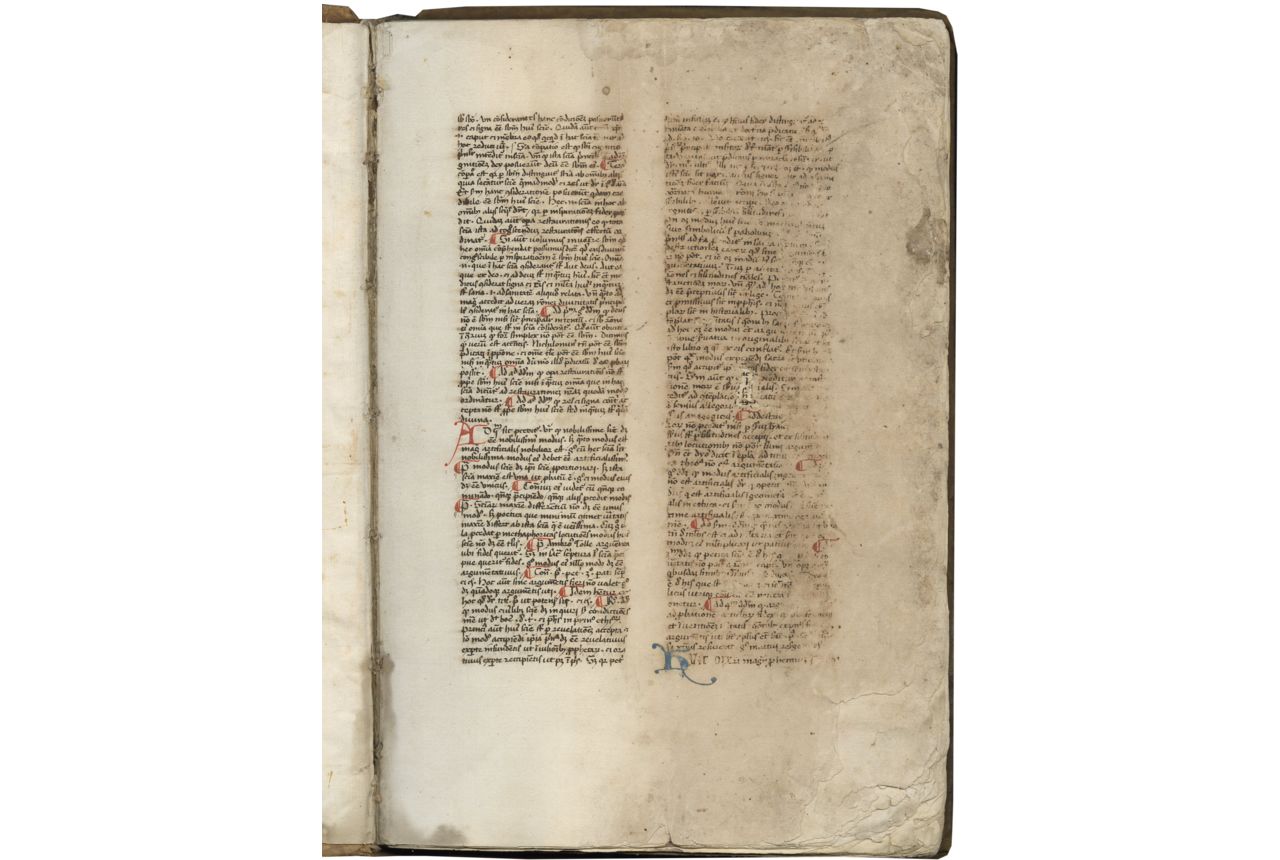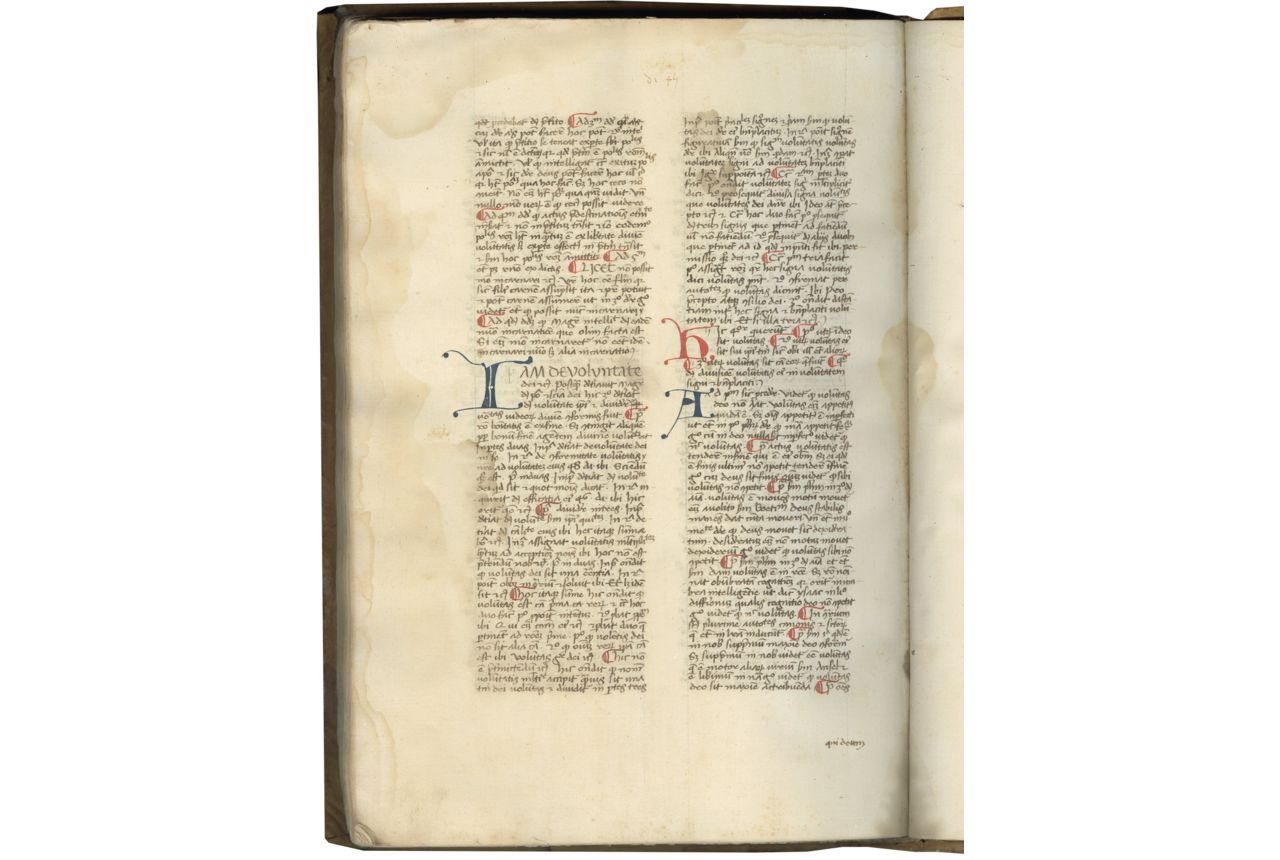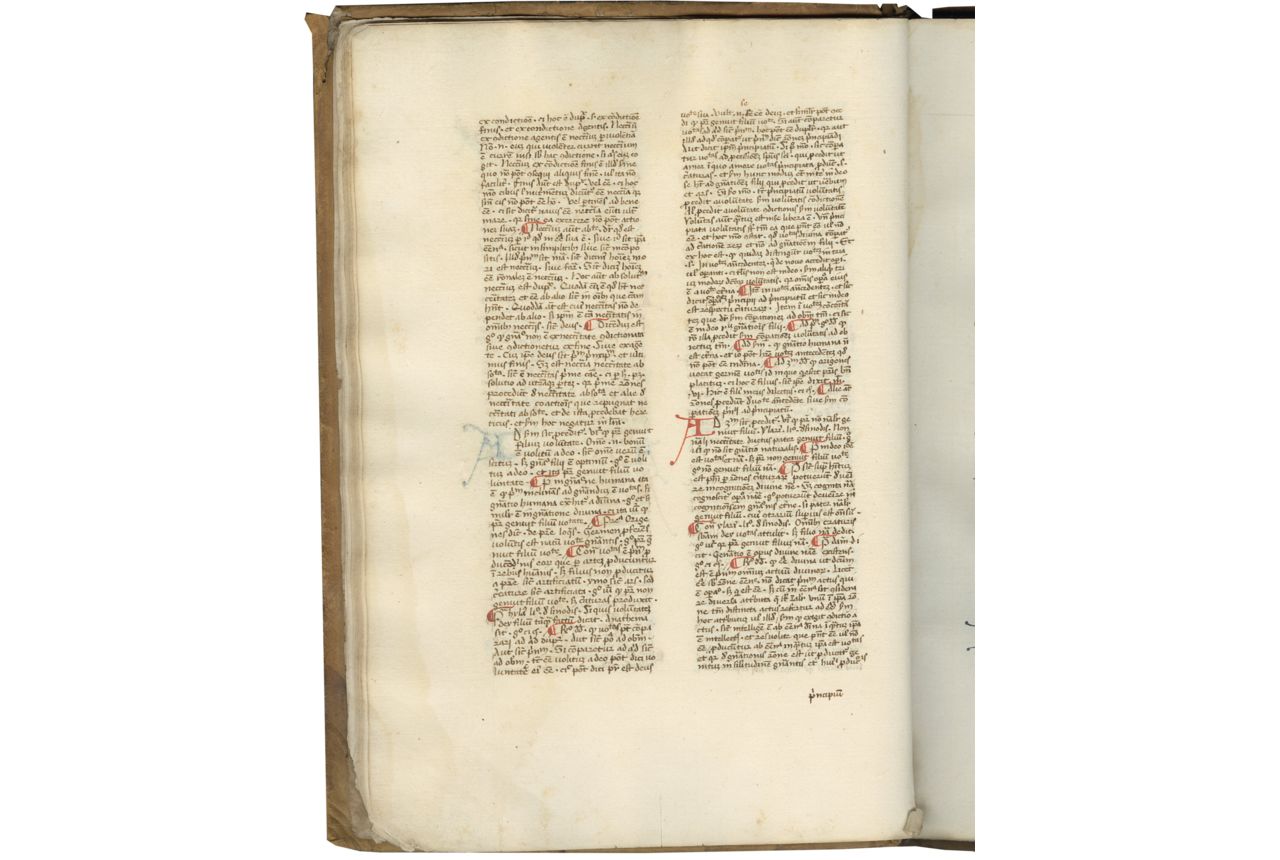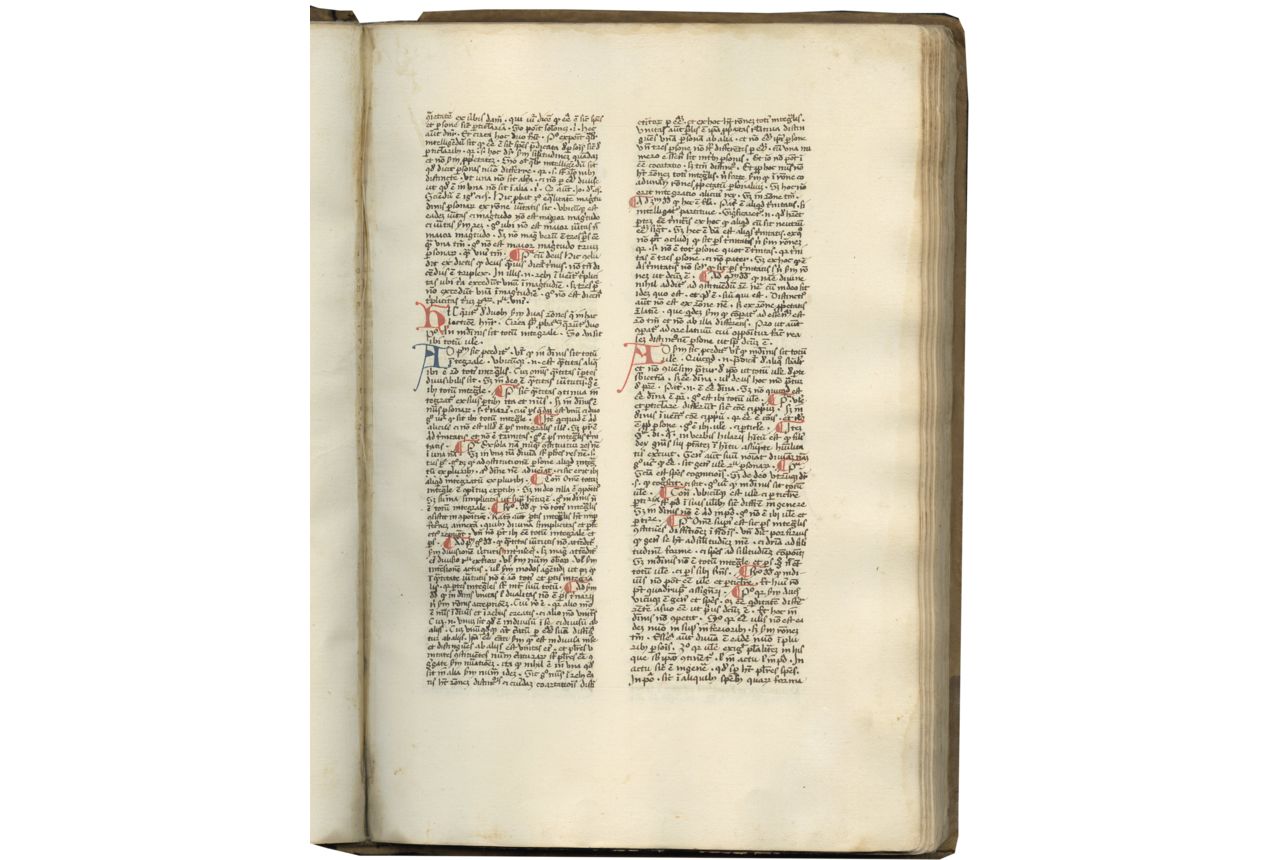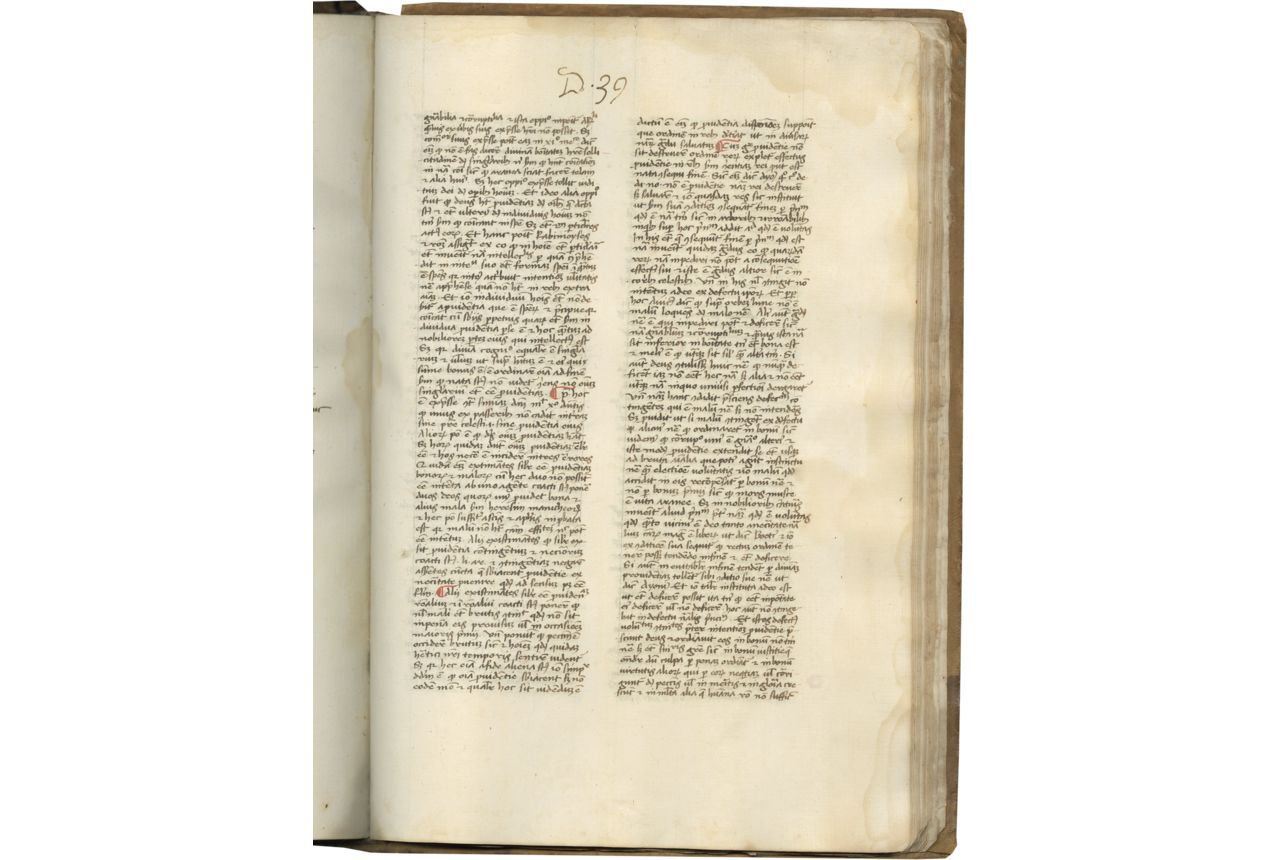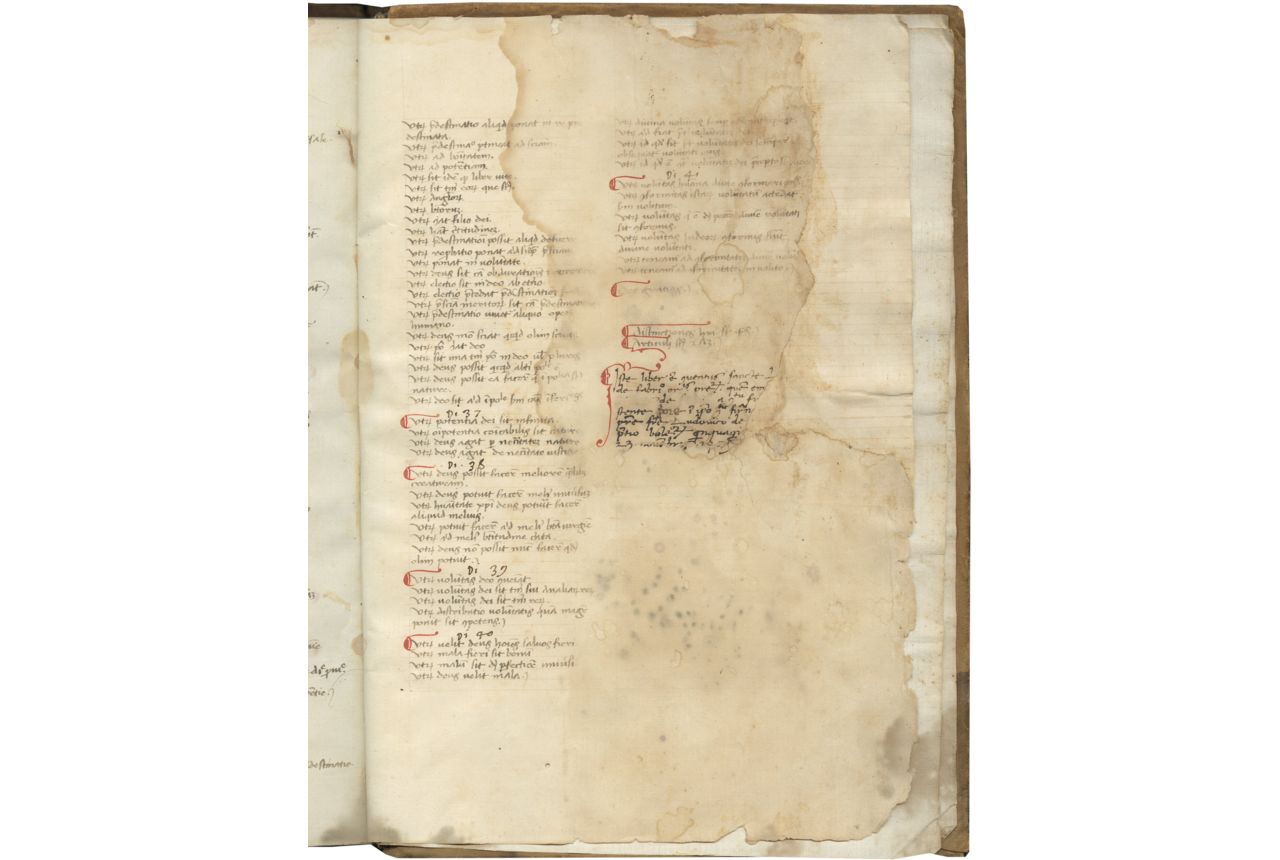134 + ii folios on paper, unwatermarked but a single paper stock, foliated 1-134 in modern pencil upper right corner rectos, lacking two leaves at front, last leaf partially defective with some loss of text (collation 110 [-1,2 missing two leaves with loss of text] ii-vi10 vii8 viii8 [-8, one leaf, cancelled blank] ix-xiv10 xv1), horizontal catchwords lower right margin last verso, ff. 1-73 leaves in first half of each quire numbered in a mixture of roman and Arabic numerals bottom center each recto, mostly cropped (evidence on ff. 11-13, 23, 49), ff. 74-134 no visible signatures, ff. 1-73 with single full-length vertical bounding lines created by scoring with a fine dry point, horizontal bounding lines very lightly ruled in lead, ff. 74-134 with single full length bounding lines lightly ruled with a fine lead point, prickings often visible in margins (justification 225-235 x 150-155 mm.), copied by two scribes, ff. 1-73 written in a small gothic book hand in two columns of 57-59 lines, ff. 74-134 written in two columns of 55 lines in an equally small but less formal hand with more cursive characteristics, red paragraph signs in text, initials alternatively in red and blue throughout, most 2- to 3-lines but up to 4- to 7-lines, the larger ones ornamented with patterns left blank within the shape of the initial, tiny guide letters in initial spaces, ff. 74-133 with contemporary invocation “ihs” or “iesus” in center upper margins (mostly cropped), slightly later headings in selected upper margins: “19” (f. 55), “D[istinctio] 39” (ff. 109-111), mild dampstaining to margins, dampstains to text, f. 1 and ff. 114-134, ff. 1-2 with small holes affecting only a few letters, ff. 1-18 and ff. 124-133 frayed at edges or corners without loss of text, f. 134 torn and mended with later paper with partial loss to ownership inscription. Binding of reversed calf over pasteboards (eighteenth-century?), frayed at corners and edges. Dimensions 225 x 237 mm.
By the greatest of scholastic theologians, the famous Saint Thomas Aquinas (1225-1274), this early work by the author sets the stage for his later classic writings such as the Summa Theologica in its insistence on traditional dogma in the formulation of a dialectical presentation. Only one other copy of Book I is found in a North American collection. Despite some unobtrusive damage at the beginning and end of the folio-sized volume, this copy is visually impressive – almost a throwback to the thirteenth-century in appearance – with its high-quality support (paper not parchment), clean generous margins, and careful well-executed script.
Provenance
1.Copied probably in the Marche region of Italy in the second half of the 15th century, when it was acquired by the Dominican convent of Santa Lucia in Fabriano. A note on f. 134, partially erased and partially missing the ends of lines where the original page was torn away, records the purchase: “Iste liber est conventus sancte L<ucie> … [torn away] | de fabri<an>o ordinis predicatorum quem em<ptum …> [torn away] | … [erased] de … [erased] a conventu fi… [torn away] | sente priore [priore in erasure] in ipso conventu fir\a/n [or m] … [torn away] | patre fratre Ludovico de … [torn away] | pretio bole<t?>orum quinquagi<nta> [torn away] | 23 novembris 14<?>3[?].” (This book belongs to the Dominican convent of Santa Lucia in Fabriano. It was bought by … from the convent in Fermo in the presence of the prior, Father and Brother Ludovico de …, for the price of 50 “boleta” on the 23rd of November 14…).
The Dominican convent in Fabriano was dedicated to Santa Lucia (St. Lucy). That community had purchased the manuscript for fifty “boleta” (an as yet unidentified unit of currency) from the Dominicans in “Firma,” probably Fermo, a town not far from Fabriano, where there was also a Dominican convent. Because of damage to the page, the year is uncertain (a previous cataloger read it as 1473). One of the first paper mills in Europe was established at Fabriano in the thirteenth century, and the city remained an important center of paper manufacture throughout the remainder of the Middle Ages and for centuries thereafter.
2. European Private Collection.
Text
ff. 1-134, begins incompletely “//sub subiecto vnde considerantes hanc condicionem … [f. 132] verbum dei filium qui hanc cognitionem in nobis per fidem initiavit cui est honor et gloria per infinita secula seculorum. Amen. Explicit scriptum sancti thome super primum sententiarum. Deo gracias. Amen. [ff.132-134] Tabula predicti libri sancti thome, incipit, “Utrum scientia theologie sit necessaria …Utrum teneamur ad conformitatem in volito. Deo gracias.” Distinctiones huius sunt 48. Articuli sunt 273; [followed by the ownership note of the Dominicans of Fabriano; see provenance above].
St. Thomas Aquinas, Scriptum super Libros Sententiarum Petri Lombardi, printed most recently by Mandonnet (1929) and available online in Corpus Thomisticum (transcribing the Parma edition of 1856; Online Resources). The prologue was edited by Oliva in 2006; and a new edition is in preparation for the Leonine Commission. Owing to the loss of the first two leaves, in this manuscript the prologue begins incompletely in the middle of Quaestio IV, Articulus IV (Mandonnet, 1929, p. 15). This volume contains only Book I of Thomas’s commentary, as it was intended to from the outset; it is conceivable that sister manuscripts containing Books II-IV might be identified. Although in the received versions of the text, Book I consists of fifty Distinctiones (see Online Resources), the text of this manuscript ends with Distinctio 41, perhaps reflecting its place in the manuscript tradition of the text.
The format of our manuscript proves that its two sections (ff. 1-73 and ff. 74-134) were copied simultaneously. The text is continuous from f. 73v, line 14, col. a, to the top line of f. 74, but the remaining space on f. 73v is blank, and a blank leaf has been removed after f. 73, indicating that the scribe of the first part, who tended to copy more lines per column than his counterpart, was unable to stretch his text to fill the entire quire, marking the end of his stint with the advice “sequere alterum in qui<n>ternium” (continued in the following quire).
St. Thomas Aquinas (1225-1274), a Dominican friar and Doctor of the Church, composed his commentary on the Sentences of Peter Lombard during the period when he was lecturing on this text while teaching in Paris in the 1250s. It was his first major work on theology, in which he presented ideas that were to be elaborated in the Summa contra Gentiles and Summa Theologica, the latter destined to become the standard textbook of Catholic theology for centuries to come. At the time when Aquinas was teaching, the Sentences had been the standard theology textbook since its compilation in the twelfth century. Peter Lombard’s (1096-1160) Libri Quatuor Sententiarum (Four Books of Sentences) was the first systematic account of Catholic theology, created by bringing together quotations from the Bible and passages from the Fathers of the Church and other authorities and organizing them by topic. Aquinas’s commentary employs the dialectical presentation characteristic of scholastic works, a form of discourse he did much to develop. Each book is divided into distinctiones, or chapters, each of which is sub-divided into articuli, or articles. Each section begins with a proposition, usually in the form of a question (quaestio), after which he cites authorities pro and con, analyzes them, and proposes a reconciliation or solutio.
The work was greatly popular in the later Middle Ages. Stegmüller’s inventory lists more than 180 manuscripts that include the work in whole or in part, all but one in European collections (Stegmüller, 1947, no. 846; see also Dondaine and Schonner, 1967-, not available for consultation). Our manuscript, as noted above, includes only book one, and many manuscripts of this text in fact include only a single book (or books). In his edition of the Prologue to Aquinas’s work, Oliva described 77 manuscripts that included the prologue and at least Book I (Oliva, pp. 25-63). Five manuscript have been recorded in American libraries, at Yale (Book III), Harvard (Book III), the Library of Congress (Book IV), St. Bonaventure University (Book IV), and the library of the Mayo Clinic, Rochester, Minnesota (contents unknown) (DeRicci, Faye & Bond, Digital Scriptorium). A sixth American copy was added by Oliva, at Northwestern University, Evanston, Illinois (Oliva, p. 29). The latter appears to be the only copy of Book I in the United States. In the fifteenth century there were two incunable editions of the complete work, with another thirteen reproducing one book only, of which three printed the commentary on Book I (GW, ISTC). Oliva lists nineteen additional printings between 1503 and 1929 (Oliva, pp. 64-66).
Literature
Bond, W. H., and C. U. Faye. Supplement to the Census of Medieval and Renaissance Manuscripts in the United States and Canada, New York, 1962.
DeRicci, Seymour. Census of Medieval and Renaissance Manuscripts in the United States and Canada, New York, 1935-1940; reprint edition, New York, 1961.
Dondaine, Hyacinthe François, and Huges V. Schooner. Codices manuscripti operum Thomae de Aquino, Paris, 1967-.
Doucet, Victorin. Commentaires sur les Sentences: Supplement au Répertoire de M. Frédéric Stegmueller. Florence, Ad claras aquas, 1954.
Mandonnet, Pierre. S. Thomae Aquinatis Scriptum super Libros Sententiarum Magistri Petri Lombardi Episcopi Parisiensis, Editio nova, Paris, 1929-1947, Vol. I.
Oliva, Adriano. Les débuts de l'enseignement de Thomas d'Aquin et sa conception de la ‘Sacra Doctrina’. Édition du prologue de son ‘Commentaire des Sentences’ de Pierre Lombard, Bibliothèque Thomiste 58, Paris, 2006, pp. 303-340.
Stegmüller, Friedrich. Repertorium Commentariorum in Sententias Petri Lombardi, Würzburg, 1947.
Online Resources
Aquinas Institute. Sentences Commentary
https://Aquinasinstitute.org/operaomnia/sentences/
Corpus Thomisticum, Thomae de Aquino Opera Omnia, Scriptum super Sententiis
https://www.corpusthomisticum.org/iopera.html
Digital Scriptorium.
www.digital-scriptorium.org
Joseph de Ghellinck, “Peter Lombard,” The Catholic Encyclopedia, vol. 11, New York, 1911
http://www.newadvent.org/cathen/11768d.htm
GW: Gesamtkatalog der Wiegendrucke
www.gesamtkatalogderwiegendrucke.de
ISTC: Incunabula Short Title Catalogue - The International Database of 15th-Century Printing
www.data.cerl.org/istc
Daniel Kennedy, “St. Thomas Aquinas,” The Catholic Encyclopedia, vol. 14, New York, 1912
http://www.newadvent.org/cathen/14663b.htm
Mirabile: Archivio digitale della cultura medievale / Digital Archives for Medieval Culture, Thomas de Aquino, Scriptum super Libros Sententiarum
http://www.mirabileweb.it/author/thomas-de-aquino-n-1224-1225-m-7-3-1274-author/19197
Peter Lombard, Sententiarum libri quattuor, ed. J.-P. Migne, Patrologia latina, vol. 192, cols. 521-961, Paris, 1833
https://books.google.com/books?id=9fEQAAAAYAAJ
S. Lucia Novella (San Domenico)
http://www.comune.fabriano.gov.it/index.php/component/content/article?id=1098
TM 1136



